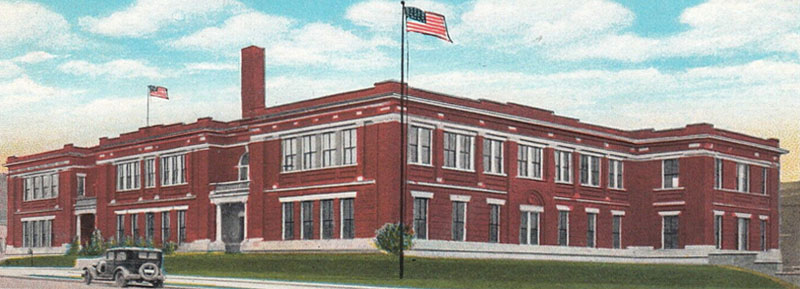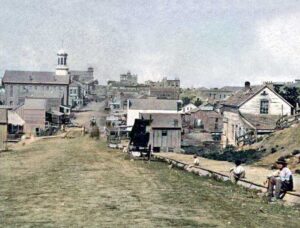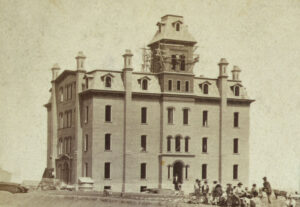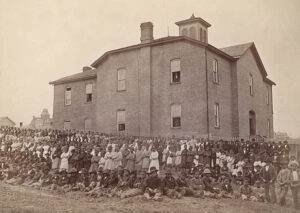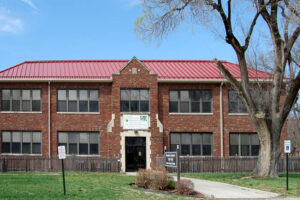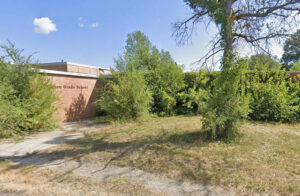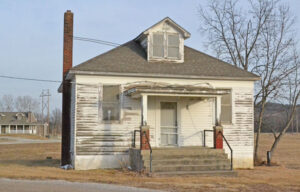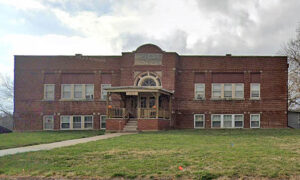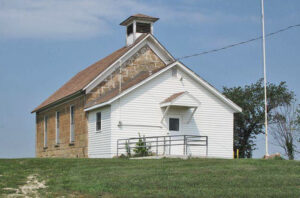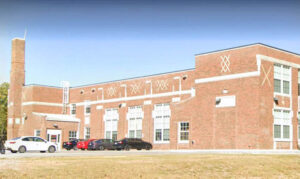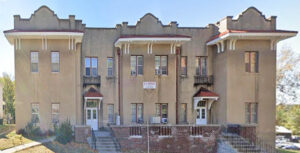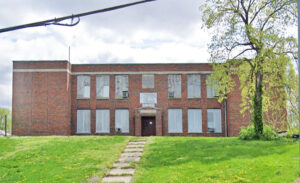In 1855, the Territory of Kansas adopted the school law of the State of Missouri, by which each district was to be controlled by an inspector and three trustees. That year, a small building was erected near the levee for a tin shop. In May, it was purchased for educational and religious purposes. Reverend J.B. McAfee, the Lutheran minister, moved the building to the southeast corner of Shawnee and Fifth Streets. This little building gave place to a two-story frame structure erected for the church but was afterward purchased by the city for school purposes. This was the first public school.
The history of the Leavenworth County schools began with the organization of the school board on July 3, 1858, with Nelson McCracken as president. The board rented N.Z. Strong’s house for ten weeks and hired George Wetherill as a teacher. Soon afterward, Miss J. Howard was employed. In August, more school accommodations were required, and J. Robertson was induced to teach in his own house for $55 per month and $16 rent. The first County Superintendent was George E. Budington, elected on December 14, 1858. Before the year’s close, the board divided the city into three districts and opened a school in each district.
During the winter, a bill was passed in the Legislature, creating the Board of Trustees into a body independent of the City Council and providing for a regular City Superintendent of Schools. At this time, the attendance of the three public schools was about 500.
James Taylor was appointed Superintendent on March 4, 1859. That month, H.D. McCarty, who had been teaching at a private institution for over a year, assumed charge of what was known as the Second District School and proposed a graded system, which was adopted. Later, he was elected City Superintendent.
The German-English School Society was organized in 1859 with G. F. Smeltzer as president. The society purchased the Strong building, where a public German school was opened to benefit the city’s large German element. The school, which imparted instruction in the German and English branches of education, was located between Fifth and Sixth Street on the south side of Seneca Street. A few years later, a sufficient sum was realized by selling this property to secure two comfortable brick buildings, which became the Third Avenue and Osage schools.
Though progress was being made, the city and county schools were very disorganized until the State system of public instruction was adopted in 1861.
In 1862, while Judge D.J. Brewer, County Superintendent, was in charge of the city schools, Governor Thomas Carney signed the act authorizing the expenditure of $25,000 to erect school buildings in Leavenworth. In pursuance of this act, the first regular public school building was erected—the Osage Street School for $12,000 on Osage Street, between Sixth and Seventh Streets.
In 1865, the board made very material additions to the school property. It leased from the city for 50 years a block known as the Public Square and purchased a two-room frame building thereon. A brick church on the corner of Oak and Seventh Streets was bought from the Westminster Society and remodeled into a comfortable two-room building used for nine years.
In 1867, the first city school building for African American students was completed in South Leavenworth, on the corner of Fourth Avenue and Prospect Street. Colored schools had been temporarily established as early as 1863 in the Christian and Baptist churches, but the brick building erected in 1867 was the first permanent structure built by the city. In 1868-1869, the colored people of North Leavenworth were accommodated by erecting a second building on the corner of Cheyenne and Fifth Streets.
In July 1868, Dr. Malcolm McVicar became City Superintendent. He was formerly the Principal of the Brockport State Normal School, New York, and an experienced educator. His coming signaled a new departure in Leavenworth’s public education system. The board was thoroughly reorganized, the magnificent three-story brick structure at the corner of Walnut and Seventh Streets, called the “Morris School,” was in progress of erection, and everything seemed ready to be shaped into a regular system. McVicar commenced a systematic course of grading in September 1868.
The Morris school building was completed within the public square for $80,000 in early 1869 in Leavenworth. However, the opposition to Mr. McVicar was so unpleasant that he resigned in March 1869 to take charge of the Potsdam State Normal School, New York. P.J. Williams succeeded him
In response to a general appeal for the founding of additional Normal Schools, the legislature of 1870 provided for the Leavenworth Normal School. The city furnished the buildings, and the school was organized with John Wherrell as president. In 1874, there were 100 students. Appropriations were received from the State for four years, amounting to $26,900. State funds were discontinued in 1875, and the following year, the normal schools of Kansas were consolidated into the Emporia Normal School, which later became Emporia State University. Afterward, the Normal School building became the high school.
The city also boasted the Osage Street School, the North and South Leavenworth Colored Schools, the wooden Shawnee Street School building, and the brick Third Avenue School.
In 1874, the two-story school building at the corner of Oak and Seventh Streets was torn down, and the Oak Street School building was erected for $27,000 on the adjoining property purchased to enlarge the grounds.
The Kansas Conservatory of Music and Collegiate School, located at 206 Fifth Avenue in Leavenworth, was organized in 1877 under Reverend Robert Brown, Director, and a board of eleven trustees. The conservatory embraced a three-year course in music and art, with moderate tuition, and the annual list of graduates was quite large.
In 1878, the site of the Grand Avenue school was purchased for $1,000, and a $4,000 brick structure was built on it.
By the early 1880s, the system was divided into the High School, Grammar, and Primary departments. The Grammar Department is divided into three grades, and the Primary into four. During the eleven years that the High School has existed, about 1,200 students have been enrolled. Of the 6,796 children of school age in the city, 3,158 were enrolled in the public schools and 856 in private institutions – a total of 3,914, a little over 50%. The value of school buildings, sites, furniture, etc., was $177,000. The educational system and the public school buildings of 1882, as contrasted with the condition of affairs in 1858, reflected Leavenworth’s growth.
By the early 1880s, Leavenworth County schools were in charge of Lyman Morgan, superintendent of public instruction. At that time, there were 78 districts, 84 schools, and as many teachers. The estimated value of the school buildings was $228,000, most of which were constructed of wood, but there were some good brick and stone buildings. The furniture and apparatus of the different schools were valued at $41,320, making the total valuation $270,000. The average monthly wages paid to male teachers was $46 and females $40. The average daily attendance at the district schools outside Leavenworth was 5,000. The receipts for 1881-82 were $58,000, and the expenditures were $56,700.
In 1885, the board secured an unfinished church and remodeled it into a new spacious high school building. It contained a large auditorium, a laboratory, an office, halls, recitation, and cloakrooms.
The Leavenworth Business College was established in 1887.
In 1890, Leavenworth’s teaching force consisted of 55 teachers, and salaries were spent totaling $38,637.
Before 1901, the educational facilities of Fort Leavenworth were limited. By an act of the Kansas State Legislature, all of the military reservations were organized into a school district called District No. 81. The Board of County Commissioners composed the school board, which was under the jurisdiction of the Leavenworth County Superintendent. The revenue derived for defraying the school’s expenses was obtained by corporate taxes, with the burden falling principally upon the railroads and the Leavenworth Water Company. The valuation of all the taxable property was about $500,000. Tax on this amount and the State School Fund furnished ample funds for the school. There were five teachers, including the principal. The government erected a well-equipped school building just east of Pope Hall on the incline overlooking the Missouri River.
Today, Leavenworth County, Kansas, is divided into six school districts, including:
Basehor-Linwood USD 458 – Located in southern Leavenworth County, the District covers 90 square miles and incorporates the cities of Basehor and Linwood. The District includes the Early Learning Center in Basehor, Basehor Elementary, Glenwood Ridge Elementary School in Basehor, Gray Hawk Elementary School in Basehor, Linwood Elementary School, Basehore Intermediate School, Basehor-Linwood Middle School in Basehor, Basehor-Linwood High School in Basehor, and Basehor-Linwood Virtual School in Basehor.
Easton USD 449 – The district is Headquartered in Easton, Kansas, and operates Pleasant Ridge Elementary, Pleasant Ridge Middle School, and Pleasant Ridge High School there.
Fort Leavenworth USD 207 – This public unified school district is headquartered in Fort Leavenworth, Kansas. The district operates Bradley Elementary School (K-6), Eisenhower Elementary School (K-6), MacArthur Elementary School (K-6), and the Patton Jr. High School (7-9). High school students attend Leavenworth High School of Leavenworth USD 453.
Lansing USD 469 – This public unified school district is headquartered in Lansing, Kansas. The district includes the city of Lansing and a small southern section of the city of Leavenworth. The school district operates the Lansing Early Childhood Center (PreK), Lansing Elementary School (K-3), Lansing Intermediate School (4-5), Lansing Middle School (6-8), and Lansing High School (9-12).
Leavenworth USD 453 – Headquartered in Leavenworth, Kansas, this district includes the central portion of Leavenworth city. It operates the Earl Lawson Early Education Center (preK-K), Anthony Elementary School (1-4), David Brewer Elementary School (1-4), Henry Leavenworth Elementary School (1-4), Leavenworth Intermediate School (part of the Warren campus (5-6), Richard W. Warren Middle School (7-8), Leavenworth High School (9-12), and the Nettie Hartnett Education Center (3rd Avenue School, Quest 18-21 Program, Virtual School).
Tonganoxie USD 464 – The district is Headquartered in Tonganoxie, Kansas, and operates an elementary, middle, and high school there.
Historic Schools of Leavenworth County
| Name | District | Years of Operation | Location & Information | |
| Easton Grade School | ?? | Leavenworth | 1950 |
The old Easton Grade School is a one-story pink brick building with metal trim and an overhang over the west façade. It has glass block windows on the west façade, a concrete addition on the south, and a wood addition on the north. The foundation was damaged in the 1993 flood, and the school closed. It is privately owned today. Located at 120 N. 1st Street, it is mainly obscured by trees. |
| Honey Valley | 56 | Leavenworth | 1916-?? | As one of four buildings on the Tonganoxie Historical Society site, the Honey Valley schoolhouse was organized on March 25, 1869. It was located about a mile south of Tonganoxie on the Gordon Harmon Farm near County Road 1 and U. S. Highway 24-40. The original building burned down in 1915. The district voted bonds for $1,200.00 to erect a new school building on June 21, 1916. This building now sits at the Historical Site after being moved there in 1991. At the one-room schoolhouse, one teacher taught all eight grades. |
| Howard Wilson Elementary | ?? | Leavenworth | 1942-2010 |
The blonde and red brick building’s north portion is two stories, while the newer south portion and east façade are one story. The West addition was added in 1950, and the Northeast addition in 1967. It was named for Howard Wilson, who donated $70k to the school district upon his death in 1939. The Kingdom Christian Academy now utilizes the building. It is located at 616 Grand Avenue, Leavenworth, Kansas. |
| Hund | ?? | Leavenworth | 1939-1965 |
The Hund School is a historic one-room schoolhouse northwest of Leavenworth, Kansas. A wood bungalow was built in 1939 on land donated to the school district by Wendelin and Josephine Hund in 1882. It replaced a school building that was destroyed in a fire. The school building is typical of other rural schoolhouses built in Kansas. The building has a cloakroom, a classroom with built-in library shelves, and a basement. Outside the schoolhouse is a hand pump for water and an outhouse. The school operated from 1939 to 1965, serving primarily children of German heritage within walking distance. It was listed on the National Register of Historic Places in 2000. |
| Lansing | ?? | Leavenworth | 1919-?? |
This one-and-a-half-story red brick Mission-style building was built for grades one through eight, replacing a former school on this site. The building has been converted to 11 apartments. The front porch is a recent addition. The building measures approximately 80′ wide by 60′ deep. Lansing School is located at 101 North Main Street, Lansing, Kansas. |
| Mayginnes School | ?? | Leavenworth | 1869 |
The old Mayginnes School was named for William Mayginnes, who donated the land in 1867 for the school to be built. The school was opened in 1869. There have been several families where five generations attended. The one-story rectangular Commercial style building sits on about an acre and was built of limestone and wood. Used as a community building today, it is located at 22017 189th Street, about six miles northeast of Tonganoxie, Kansas. |
| North Broadway | ?? | Leavenworth | 1923-1998 |
Built as an elementary school and closed in 1998. The first day of school at North Broadway School was September 17, 1923; 382 students attended. The school district relocated its elementary classes out of the building in 1999 and then operated several special programs, including an alternative high school, in the building until 2010. It was added to the National Register of Historic Places as part of the Historic Public Schools of Kansas nomination in October 2011. Today, this rectangular two-story brick Tudor Revival style building serves as Broadway Lofts. It is located at 801 N. Broadway Street. |
| Oak Street | ?? | Leavenworth | 1874-1924 |
The old Oak Street School is a two-story Spanish Eclectic-style stucco building with red tile awnings over the East entrances and under curved parapets. The property was sold in 1927 and was likely converted into apartments then. Called A&K Rentals today; it is at 514 South 7th Street in Leavenworth, Kansas. |
| Sumner Elementary | Leavenworth | 1925-1969 |
Sumner School was one of two elementary schools built to serve Leavenworth’s African-American students in the 19th century. Lincoln School served students living in North Leavenworth; Sumner served the students living in South Leavenworth. The first Sumner School was constructed in 1866 and remodeled in 1899. By 1915, however, the original building was unable to meet the needs of its 185 students. School principal Dr. Blanche Bruce oversaw the construction of the new building in 1924 and 1925. In the spring of 1960, Abeles and Cleveland Schools were closed and consolidated into Sumner and Anthony Schools. At this time, Sumner housed the 3rd-6th grades. The school was closed at the end of the 1968-1969 school year due to a structural engineer’s report that it was not feasible to improve the building to continue use as a school. During the 1969-1970 school year, this building was converted to a district maintenance facility. It is an activity center for the Pentecostal Church of Apostolic Faith today. This rectangular two-story commercial-style building has a flat roof with a parapet. It is located at 1501 5th Avenue in Leavenworth, Kansas. |
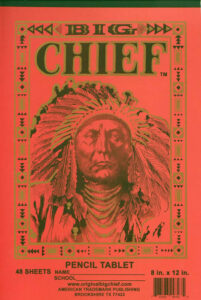
Chief Tablet
©Kathy Alexander/Legends of Kansas, May 2024.
Also See:
Sources:
Cutler, William G; History of Kansas; A. T. Andreas, Chicago, IL, 1883.
Historic Public Schools of Kansas
Kansas Historic Resources Inventory
Kansas State Historical Society, The Columbian History of Education in Kansas, Hamilton Printing Company, Topeka, KS, 1893.

